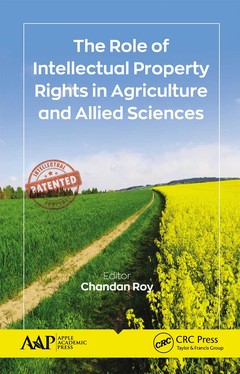Description
The Role of Intellectual Property Rights in Agriculture and Allied Sciences
Coordinator: Roy Chandan
Language: English
Subjects for The Role of Intellectual Property Rights in Agriculture...:
Keywords
Trip Agreement; Plant Genetic Resources; Patentable Subject Matter; Tamil Nadu; Recombinant DNA; Darjeeling Tea; ICAR National Bureau; National Biodiversity Authority; Isolate DNA Sequence; Plant Varieties; Budapest Treaty; PVP System; National Gene Fund; SEQ Id; Genetic Resources; GI Registration; Indian Patents Act; BMC; Indian Patent; SMTA; Biological Diversity Act 2002; WIPO Website; Ipo; Gene Patenting; Bidhan Chandra Krishi Viswavidyalaya
Publication date: 03-2021
Support: Print on demand
Publication date: 09-2018
· 15.2x22.9 cm · Hardback
Description
/li>Contents
/li>Biography
/li>
This important volume provides a basic understanding of the different forms of intellectual property rights in agricultural science. It provides an abundance of information on the use of IP laws in agriculture and allied subjects and their proper implementation in real-life practice. The chapter authors discuss different kinds of IP laws and their current status in developed as well as developing countries throughout the world.
The protection of biological resources is crucial for food security for future generations. Biological resources are the source of several important genes. Researchers are interested in the development of plant varieties that can increase crop production, withstand dramatic climatic changes, etc. Protecting intellectual property rights in plant varieties and the rights of farmers and others are discussed in this volume. It also looks at new trends and developments in the field involving new IP strategies and the application of IP laws in agriculture and biotechnology and in the management of plant genetic resources.
About the Editor. List of Contributors. List of Abbreviations. Acknowledgments. Preface. 1. IPR in Agriculture and Their Prospects. 2. Biodiversity Conservation and Agricultural Intensification in India through Integration of IPR. 3. Application of IPR to Conserve Global Genetic Resources for Commons. 4. Traditional Knowledge and Its Promotion Through Providing Legal Rights. 5. Protecting Plant Breeders’ Rights in Agricultural Research and Development. 6. Farmers’ Right and Privileges: Implication for the Farming Community. 7. Patenting of Microbiological and Biotechnological Inventions: The Global and Indian Scenarios. 8. Geographical Indications in Indian Agriculture. 9. Protecting Non-Basmati Indigenous Aromatic Rice Varieties of West Bengal, India Under Geographical Indication: A Critical Consideration. 10. An Agricultural Perspective on Patentability of Genes. 11. Awareness Generation, Scope, and Scenario of Intellectual Property Rights in Agriculture. Index.
Chandan Roy, PhD, is an Assistant Professor-cum-Junior Scientist in the Department of Plant Breeding and Genetics, Bihar Agricultural University, Sabour, Bhagalpur, India. He is the author of several books and book chapters, as well as over a dozen peer-reviewed journal research papers and articles, and he has presented research findings at more than 10 seminar/symposia. Presently he is the In-Charge of Intellectual Property Right Cell of Bihar Agricultural University, as well as the university’s Nodal Officer of the national-level program on PPV&FRA-2001 (Protection of Plant Varieties and Farmers' Rights Act, 2001). He has delivered lectures on different aspects of international property rights (IPR) at state- and national-level institutes. He has also conducted a national conference on IPR in agriculture. In addition, he is engaged in an awareness generation program among the farmers of Bihar, India, regarding farmers’ rights; he has trained more than 3500 farmers regarding IPR and framers’ rights. Dr. Roy is a member of the national-level expert committee on registration of essentially derived varieties (EDVs) under the PPV&FR Act 2001, Government of India. He is also a member of the Prioritization, Monitoring and Evaluation (PME) Cell of the university extension and training group. Dr. Roy is engaged in teaching of undergraduate and postgraduate students and directs research activities in the wheat and cauliflower improvement program.



